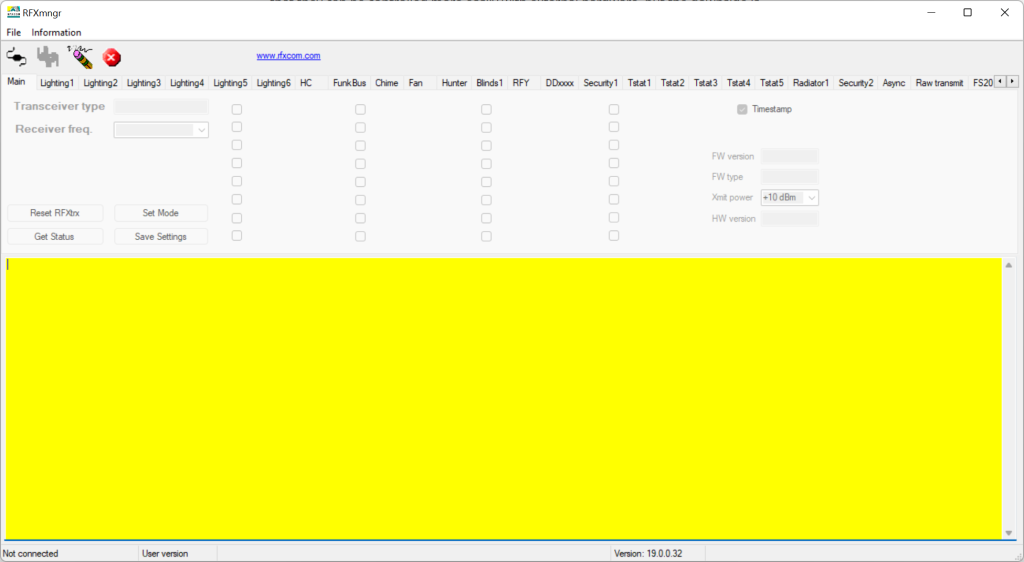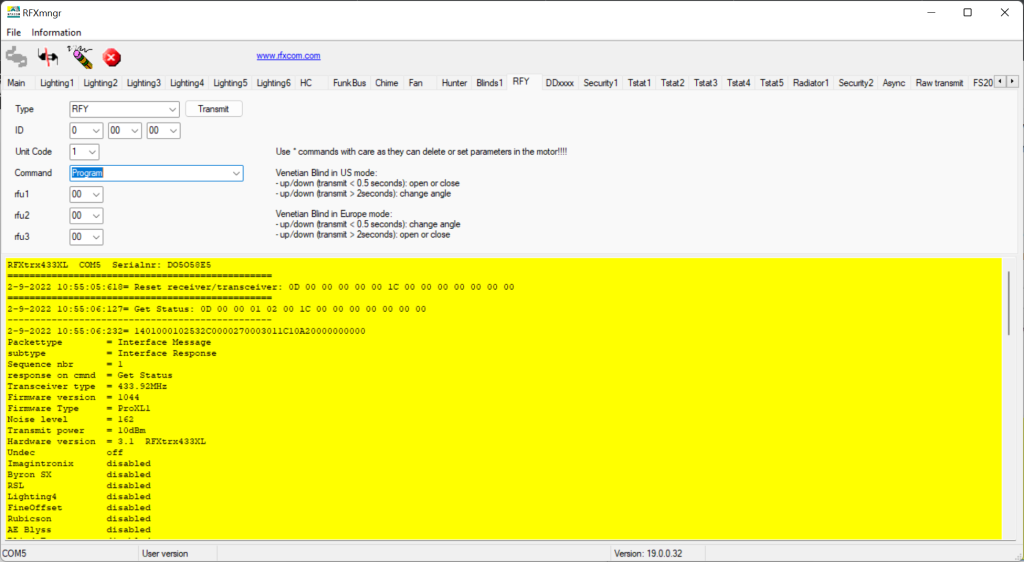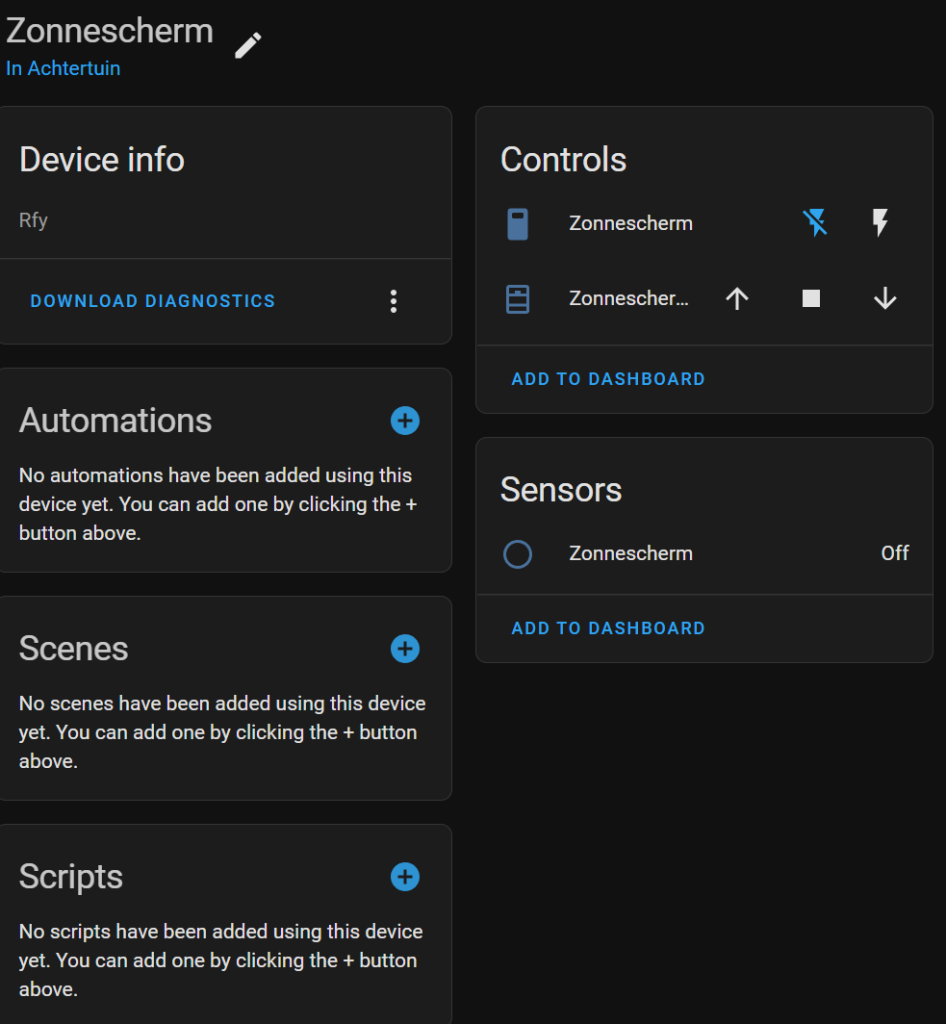Time for a new post about a completely different subject. Last year we bought a new house, so it was time to start with some more serious smart home setup. I decided to go for Home Assistant, installed on a Raspberry Pi 4B paired with an SSD for reliability (as SD cards go bad over time when a lot of data is being written).
We installed electrical roller blinds at various windows to prevent heat coming inside during summer and wanted a way to control those as well with Home Assistant. The roller blinds are equipped with Somfy RTS motors, which can be controlled using a remote. The RTS motors have as advantage that they can be controlled more easily with external hardware, but the downside is that it only supports communication in one-direction. It is not communicating back state of various components. This means that when you open a shutter, the system never knows if it actually opened and also how far. Somfy io (also called io-homecontrol) does support this, but is a proprietairy protocol and requires specific hardware (like a TaHoma switch) which also needs to be connected to the cloud in order to use it and is just another brick in your house which needs to be powered 24/7. Note: Make sure to check which motor type you have or check it before you buy it!
To integrate Somfy RTS into Home Assistant, I decided to buy a specific piece of hardware to allow to send out RF signals to the Somfy RTS motors around the house. I bought the RFXtrx433XL, which you can connect using USB to a Raspberry Pi or other device to send out RF signals (on 433MHz) to various devices. However I struggled with configuring the Somfy RTS motors the first time and couldn’t find an easy guide so that’s the reason why I describe here the steps how to configure RFXCom properly together with Somfy RTS. Later I also explain how to configure the devices then in Home Assistant so that you can use them within Dashboards, Automations, etc.
Programming RFXtrx with Somfy RTS
First step is download RFXmngr. Check the link to find the latest available version and install it. Then connect the RFXtrx to your computer and open up RFXmngr.

You will see a screen like above and need to click on File -> Connect. When you’ve connected an RFXtrx usually the com port is automatically selected:

Note: There are also RFXtrx versions available with network capabilities and are not directly connected to a computer. In that case it should be possible to use TCP/IP and by using the right IP and Port number to connect over ethernet.
Then navigate to the RFY tab:

Here a few things are important:
- ID
This indicates the unique id - Unit Code
Each unique id supports up to 5 devices, which are called units - Command
This is needed to send a specific command to the device. In this case we must set it to program as we’re going to program some shutters to control them with RFXtrx.
My suggestion is to create some spreadsheet to keep track of all devices and unique id’s. I started with ID 00 00 00 and Unit Code 0. Then for the second device I increased the Unit Code. And then after Unit Code 4, I increased ID to 00 00 01 and start again with Unit Code 0 and so on. This way it is easier later to program all the devices in Home Assistant with the right code. Also already prefix the Unit Code with a 0 in your spreadsheet as you need this later on in this format for adding devices in Home Assistant.
Next step is to actually set the devices in programming mode to program the RFXtrx. To do this you need a few items:
- Remotes of all devices you want to program
- A pen or small screwdriver to put the remote in programming mode
First in RFXmngr set the ID and Unit Code to the desired configuration. Then make sure to set Command to Program. Then walk to the device which you want to program with the remote. On the back of the remote is a hole and with a pen or screwdriver you need to short circuit this to set it to program mode. The device should respond with opening and closing shortly to indicate that it is set to program mode. Sometimes it is a bit fiddly and you need a few tries to get this done. When the device indicated it is in programming mode, click on the Transmit button in RFXmngr. Then the device should again quickly open and close. That is an indicator it has been programmed. Make sure to write down in your spreadsheet which device it is, such that you later can rename the device in Home Assistant again. Now you can also test easily the device. If you for example change the Command to Down and then click on Transmit again, the device should move to the down position. Repeat this process until all devices have been programmed, and make sure that each device has a unique combination of ID and Unit Code! When finished it is time to close RFXmngr and disconnect the RFXtrx from the computer.
Configure RFXCOM in Home Assistant
Connect the programmed RFXtrx to your device running Home Assistant. Next step is to open Home Assistant and go to Settings -> Integrations. Then click on add Integration and search for rfxcom:

Add the integration and also check to box to automatically add new devices. For some reason in my case this not always work, so you might need to add the devices manually to Home Assistant. I will describe here how to add the earlier programmed devices manually.
As this guide describes, there is a fixed way how devices codes are working within RFXCOM. All Somfy RTS devices needs to be prefixed with 071a000 followed by the ID and the Unit Code. So the code should be something like this: 071a0000[id][unit_code]
Make sure to refer to your spreadsheet and lookup each ID and Unit Code. For the Unit Code is stated that is always should be prefixed with a 0. So when the Unit Code is for example 0 (as shown in the UI of RFXmngr) then the Unit Code is 00. In our example for the first device the code should be: 071a000000000000
In Home Assistant, on the integrations screen click on the Configure link on RFXCOM. Then a window should open like below:

In the middle textbox, you can enter manually the event code. In this case that is the code we determined earlier. Enter it and click save. Then a new entity should have been created in Home Assistant. Make sure to rename the device to a proper name and you can also assign it to a specific room to allow later to use it in automations for a specific room, etc. Then it should look like this:

You can now also test the device directly by clicking the up and down icons. Then the device should go up or down if possible. When that works, you can confirm the device has been configured correctly. Repeat these steps for other devices until all programmed devices are added to Home Assistant.
After configuring, you can do whatever you want to use the entities in dashboards or use them within Automations, Scenes or Scripts like with any other integrations.
Great explanation!
As I don’t have access to any Windows machine (only running MacOS at home), is there a way to solve this without using RFXmngr?
According to the documentation of RFXtrx the tool doesn’t work on any other systems unfortunately.
Bookmark made. I use it when I have time to switch from Domoticz to HA.
Inmiddels overgestapt van Domoticz naar Home Assistant. Overigens wat een verademing. Eenvoud stabiel.
alles werkt. RfxfcomXL somfy rollgordijnen 2x vouwgordijnen 3x Youless airco nefit easy omnik zonnepanelen kaku bose tfa regenmeter deurbel en nog zoveel meer.
Hi jeroen lost jouw beschreven manier de one way communicatie probleem op van RTS? Kun je bijv de huidige status inzien?
Nee helaas niet. RTS is in de basis one-way communicatie dus in feite heb je nu een software controlled afstandsbediening die je vanuit HA kan aansturen en eventueel automation rules op kan toepassen. Misschien dat er wel andere oplossingen voor bestaan, maar daarvan ben ik niet op de hoogte.
Dank voor je reactie! Ik heb momenteel de somfy bridge waar je hetzelfde mee kan bereiken maar daar betaal je meer voor.
Thanks for this explanation. Worked for me. Now i can go on and look for controlled screens by wheather conditions.
You deserve a coffee 😉
Fantastic explanation! Thank you!
So far, everything is working fine on my side – the awning is going out/in.
However, the ends are swapped. When it ‘s closed, it shows open and vice versa.
Have you found any way to reverse that?
In Domoticz which I used previously for this, there is a reverse config – however, I haven’t found that in HA yet…
Many thanks in advance!
Not sure. I didn’t experience this behavior myself. Not sure if it is solvable in HA. Maybe try to reach out to the folks on GitHub taking care of the integration.
Hi,
having the same issues setting this up as you originally had I think.
I see you installed new shutters though while I’m trying to integrate my existing ones without disturbing their daily function (read: can’t brake the wife’s remote 🙂 )
the way you program them, does that include defining the up and down position of the shutter again? Because that is all set on mine already so I don’t want to have to reprogram everything all over.
On a second note, all my shutters have their own remote but I also have one that can control 4 shutters. When I assign those Id’s and unit numbers, does that change anything on the order they are currently programmed in that remote you think? I guess I’m just wondering if it would not be possible to figure out what ID + unit combo the shutters already have now so I can keep that..
You would not happen to know how that works? 🙂
thanks
Maarten
Sorry for the late reply. When you put the remote which only controls one device in programming mode, you actually put the motor unit in programming mode and not the remote. That allows new remotes, which the RfxCom actually replicates, to pair with the motor as there is a rolling code security scheme involved when sending the commands. So all remotes keep if you don’t fiddle with the other buttons when it is in programming mode working as is.
hi Jeroen
heb ook mijn home assistant draaien met Somfy en Brel rts motoren met rfxcom
Kan echter nergens vinden hoe ik van mijn Brel rts de my postion kan overnemen
Dat zijn namelijk zogenaamde duo rolgordijnen die op een bepaalde hoogte moeten opengaan
Weet Jij of kun jij me in de juiste richting wijzen
alvast bedankt
johnny
Ik zou het zelf zo niet weten. Ik denk dat zaak is dat je met het tooltje RfxCom eerst de juiste code weet te pakken te krijgen. Je kan in RFXmngr het commando bewerken en ook testen voordat je de dongle in combinatie van een ander apparaat gebruikt. Ik zou daar eerst eens mee spelen en dan kijken of je het gewenste commando te pakken weet te krijgen. Ik gebruik het zelf totaal niet, omdat ik rolluiken altijd volledig open of dicht wil hebben.
I just needed to implement one RTS blinds. 5 minutes… brilliant.
Thank you for all the great guide.
I would add one sentence on HA, metnioning you don’t need to select a protocol.
Regards,